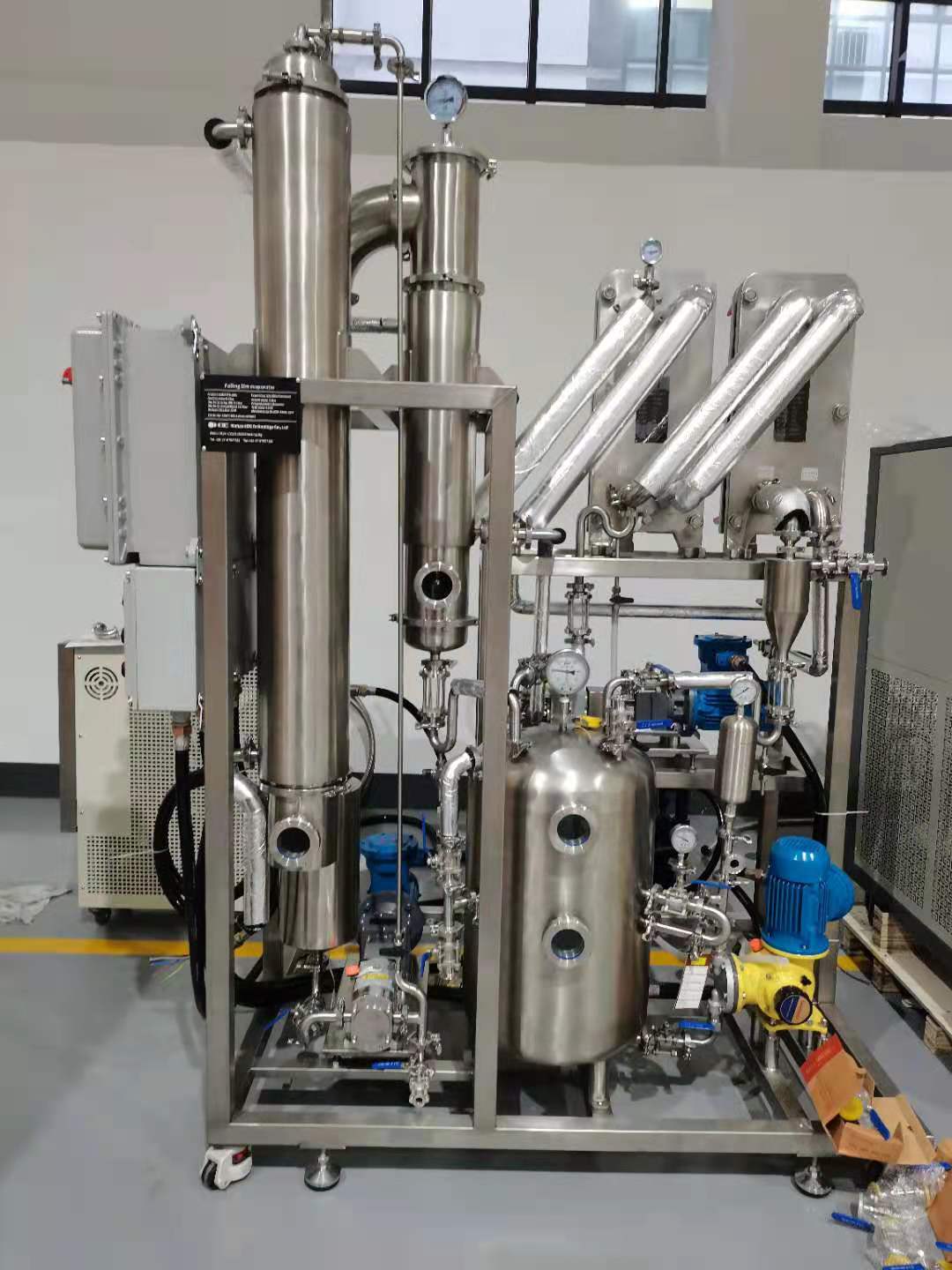Thin film evaporation is a process that allows liquid to form a thin film for efficient evaporation. Its core is to use the large specific surface area and short heating time of the film to achieve rapid separation of solvent (or water) and solute.
Depending on the different ways of forming the liquid film, common types include:
Falling film evaporation: gravity is used to form a liquid film along the wall of the heating tube (described in detail above).
Rising film evaporation: The liquid is heated and boiled in the heating tube, and the generated steam drives the liquid to flow upward along the tube wall to form a liquid film, which is suitable for low-viscosity and easily foaming materials.
Scraped film evaporation (rotary thin film evaporation): The liquid is forced to be scraped into a uniform liquid film by a rotating scraper. It is suitable for high-viscosity, heat-sensitive or easily crystallized materials, and can avoid local overheating.
Falling film evaporation is an efficient evaporation process. Its core principle is to allow the liquid to form a uniform film on the inner wall of the evaporation tube and evaporate under heat. The specific process is as follows:
Principle
The liquid is evenly distributed on the inner wall of the evaporation tube through a film distribution device (such as a distributor, a guide tube, etc.). Under the action of gravity and steam shear force, it flows down along the tube wall and forms a thin liquid film. At the same time, the heating medium (usually steam) passes through the outside or inside of the tube, transfers heat to the liquid film through the tube wall, and quickly vaporizes the water in the liquid film to form secondary steam, while the concentrated liquid is discharged from the bottom of the tube.
Features
The liquid film is thin, the heat transfer efficiency is high, and the evaporation speed is fast.
The liquid stays in the tube for a short time, which is suitable for processing heat-sensitive materials (such as ingredients in food and medicine) and reducing the damage to the material caused by high temperature.
Compared with other evaporation methods (such as rising film evaporation), falling film evaporation has lower requirements on the fluidity of the liquid and is more suitable for materials with high concentration or slightly higher viscosity.
Application
Falling film evaporation has the characteristics of efficient heat transfer, short material heating time, and good adaptability to viscosity. It is widely used in many fields, mainly in scenarios where solutions need to be concentrated and purified, as follows:
Food industry
It is used for the concentration of juice, jam, dairy products (such as milk concentrate), sucrose, glucose, etc., which can reduce the damage of high temperature to food nutrients (such as vitamins and flavor substances) and retain the original quality of the product.
For example, in juice processing, excess water is removed by falling film evaporation to obtain concentrated juice, which is convenient for storage and transportation.
Medicine and bioengineering
It is suitable for the concentration of heat-sensitive materials such as Chinese medicine extracts, antibiotic solutions, and biological agents to avoid the decomposition and failure of effective ingredients due to long-term high temperature.
For example, in the preparation of Chinese medicine extracts, falling film evaporation can be used to quickly concentrate the medicine at a lower temperature and improve the retention rate of effective ingredients.
Chemical industry
It is used for the concentration of various chemical solutions, such as the purification or concentration of salt solutions (sodium chloride, potassium chloride, etc.) and organic solutions (ethanol, ethylene glycol, etc.). For some chemical raw materials with medium viscosity and difficulty in crystallization, falling film evaporation can efficiently separate solvents and solutes and reduce energy consumption.
Environmental protection and water treatment
In wastewater treatment, it can be used to concentrate high-concentration organic wastewater or salt-containing wastewater, reduce the volume of wastewater, and facilitate subsequent treatment or recovery of useful substances.
For example, wastewater containing heavy metals can be concentrated to reduce the processing volume and improve resource recovery efficiency.
In short, falling film evaporation is particularly suitable for treating heat-sensitive and medium-viscosity materials, and is prominent in scenarios where efficiency and material stability need to be taken into account.

Oleoresins Introduction
Stainless Steel Mixing Equipment Application
Plate Centrifuges Application
Contact: Project Manager
Phone: +86-18120438367
Tel: +86-18120438367
Email: info@tycoretech.com
Add: No. 1, Optics Valley Avenue, East Lake New Technology Development Zone, Wuhan, Hubei, China
We chat
